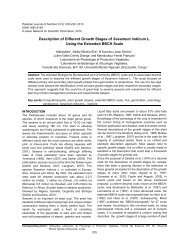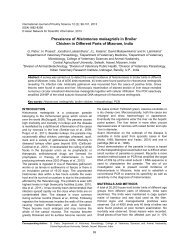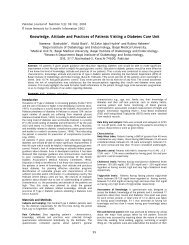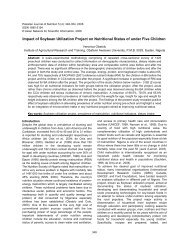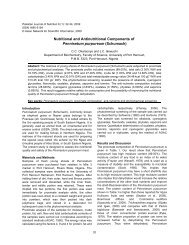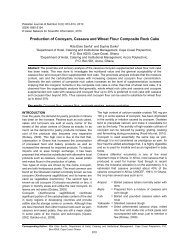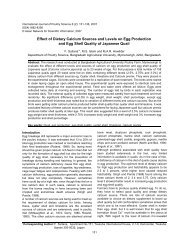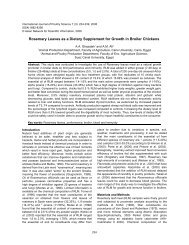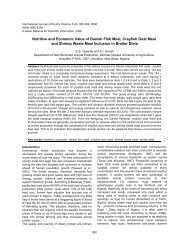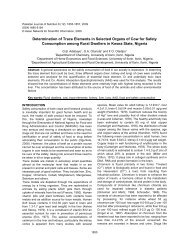sensory evaluation of tigernut beverage in cape coast district of g
sensory evaluation of tigernut beverage in cape coast district of g
sensory evaluation of tigernut beverage in cape coast district of g
Create successful ePaper yourself
Turn your PDF publications into a flip-book with our unique Google optimized e-Paper software.
Pakistan Journal <strong>of</strong> Nutrition 8 (5): 688-690, 2009<br />
ISSN 1680-5194<br />
© Asian Network for Scientific Information, 2009<br />
Production and Sensory Evaluation <strong>of</strong> Tigernut Beverages<br />
Rita E. Sanful<br />
Department <strong>of</strong> Hotel, Cater<strong>in</strong>g and Institutional Management, Cape Coast Polytechnic,<br />
P.O. Box AD 50, Cape Coast, Ghana<br />
Abstract: The acceptability <strong>of</strong> roasted and non-roasted tiger nut <strong>beverage</strong>s has been <strong>in</strong>vestigated. Forty<br />
panelists were used <strong>in</strong> the <strong>sensory</strong> <strong>evaluation</strong> study. The panelists compared the two <strong>beverage</strong>s on the<br />
bases <strong>of</strong> mouth feel, texture, taste, aroma, consistency, appearance and general acceptability. Correlation<br />
analysis <strong>of</strong> the results showed that although the texture, aroma, appearance and consistency were important<br />
for consumers, mouth feel and taste were more important for the overall acceptance <strong>of</strong> the <strong>beverage</strong>s. The<br />
mouth feel <strong>of</strong> the non-roasted tiger nut <strong>beverage</strong> was more acceptable than that <strong>of</strong> the roasted tiger nut<br />
<strong>beverage</strong>. The taste <strong>of</strong> the roasted tiger nut <strong>beverage</strong>, however, was more acceptable to the panelists than<br />
that <strong>of</strong> the non-roasted tiger nut <strong>beverage</strong>. General preference is given to the roasted tiger nut <strong>beverage</strong>.<br />
Key words: Tiger nut <strong>beverage</strong>s, Ghana, diet<br />
INTRODUCTION<br />
Ghana <strong>in</strong> recent times has witnessed <strong>in</strong>creas<strong>in</strong>g<br />
awareness <strong>of</strong> the dietary <strong>in</strong>take <strong>of</strong> the ord<strong>in</strong>ary Ghanaian<br />
and its effect on his health status. Despite this<br />
awareness, however, Biritwum et al. (2005) reports that<br />
the country is still faced with cont<strong>in</strong>ued rise <strong>in</strong> the<br />
prevalence <strong>of</strong> obesity alongside high levels <strong>of</strong> diet<br />
related health conditions. Enough evidence notable <strong>in</strong><br />
speeches <strong>of</strong> most health practitioners po<strong>in</strong>ts out that<br />
substantial changes <strong>in</strong> our diet at the micro-level would<br />
decrease the reported cases <strong>of</strong> various health related<br />
conditions such as cardiovascular disease, diabetes<br />
and cancer, as well as obesity.<br />
S<strong>in</strong>ce a change <strong>in</strong> the diet <strong>of</strong> a population is difficult and<br />
<strong>of</strong>ten requires a shift <strong>in</strong> the food habit <strong>of</strong> the people,<br />
small changes <strong>in</strong> the <strong>in</strong>take <strong>of</strong> various nutrients from<br />
mixed food sources may confer health benefits that may<br />
possibly improve the nutritional status <strong>of</strong> most<br />
Ghanaians.<br />
The prevalence <strong>of</strong> obesity and the high level <strong>of</strong> diet<br />
related health conditions have generated a lot <strong>of</strong> concern<br />
about our dietary <strong>in</strong>take and its effect on our health. The<br />
need to make more <strong>in</strong>formed choices regard<strong>in</strong>g food<br />
preferences among the Ghanaian folks cannot be<br />
overemphasized. In the light <strong>of</strong> these problems, the tiger<br />
nut has been recognized as one <strong>of</strong> the best nutritional<br />
crops that can be used to augment the diet (Afenu,<br />
2008). The tiger nut crop is one <strong>of</strong> the cash crops, which<br />
is not given due recognition and patronage possibly<br />
because many people do not know its nutritional<br />
benefits.<br />
Tiger nut, (Cyperus esculentus I.), is a vigorous plant<br />
with leafs <strong>in</strong> rosette and measures from 40-50<br />
centimeters. It possesses a rhizomatic radicular system,<br />
from which depart small roots <strong>in</strong> which extremes the<br />
tiger nuts are formed. The tiger nuts acquire two forms:<br />
"largueta" (prolonged) and "armela" (rounded). Initially,<br />
the root crop produces leaves and flourishes as plants<br />
do but as the days become shorter and cooler, leaf<br />
production will cease and tubers will be formed. High<br />
temperatures and low nitrogen levels <strong>in</strong>crease tuber<br />
production.<br />
Tiger nuts, accord<strong>in</strong>g to Abodunr<strong>in</strong> and Belewu (2008)<br />
was found to be a good substitute for cereal gra<strong>in</strong>s. The<br />
nut which is cultivated throughout the world are also<br />
found <strong>in</strong> the Northern part <strong>of</strong> Nigeria and other West<br />
African Countries like Gu<strong>in</strong>ea, Cote d’ivore, Cameroon,<br />
Senegal, America and other parts <strong>of</strong> the world (Irv<strong>in</strong>e,<br />
1969 <strong>in</strong> Abodunr<strong>in</strong> and Belewu, 2008). The nuts are<br />
valued for their highly nutritious starch content, dietary<br />
fibre and carbohydrate. The nut is reported to be rich <strong>in</strong><br />
sucrose (17.4-20.0%), fat (25.50%) and prote<strong>in</strong> (8%)<br />
(Kordyias, 1990 <strong>in</strong> Abodunr<strong>in</strong> and Belewu, 2008) The nut<br />
is also rich <strong>in</strong> m<strong>in</strong>eral content (sodium, calcium,<br />
potassium, magnesium, z<strong>in</strong>c and traces <strong>of</strong> copper<br />
(Omode et al., 1995, <strong>in</strong> Abodunr<strong>in</strong> and Belewu, 2008).<br />
The tiger-nut crop has been found to be a healthy tuber<br />
with a high content <strong>of</strong> oleic acid, positive effects on<br />
cholesterol levels and high content <strong>of</strong> Vitam<strong>in</strong> E. It is<br />
highly recommended for diabetics, children, older<br />
persons and sportsmen. This study was conducted to<br />
extract and formulate milk from roasted and non-roasted<br />
tiger nut <strong>in</strong>to palatable <strong>beverage</strong> and to evaluate the<br />
qualities and consumer acceptability <strong>of</strong> these<br />
<strong>beverage</strong>s.<br />
MATERIALS AND METHODS<br />
Fresh tiger nuts were purchased from the Kotokuraba<br />
market <strong>in</strong> Cape Coast, Central region <strong>of</strong> Ghana.<br />
Preparation <strong>of</strong> the tiger nut milk was done by pick<strong>in</strong>g out<br />
those foreign and bad nuts that could affect the taste and<br />
keep<strong>in</strong>g quality <strong>of</strong> the <strong>beverage</strong>. Two preparations were<br />
made from non roasted tiger nuts and roasted tiger nut.<br />
For the preparation <strong>of</strong> tiger nuts milk from the non<br />
688
Pak. J. Nutr., 8 (5): 688-690, 2009<br />
roasted, the nuts were soaked overnight for Sort<strong>in</strong>g <strong>of</strong> tiger nuts<br />
approximately 12 h after which it was washed thoroughly<br />
and blended by add<strong>in</strong>g 600 ml <strong>of</strong> water to 400 g <strong>of</strong> tiger<br />
nut. It was then filtered us<strong>in</strong>g musl<strong>in</strong> cloth apply<strong>in</strong>g<br />
pressure to the content to achieve maximum liquid<br />
extraction. The filtrate was put <strong>in</strong>to a clean double<br />
bottomed saucepan and brought to the boil. It was then<br />
allowed to simmer for between 15 and 20 m<strong>in</strong> to avoid<br />
curdl<strong>in</strong>g and then allowed to cool. Figures 1a and 1b<br />
shows the flow chart for the preparation <strong>of</strong> the tiger nut<br />
milk. The cooled filtrate was poured <strong>in</strong>to a sterilized<br />
bottle and further sterilized. It was then allowed to cool<br />
and refrigerated. For the preparation <strong>of</strong> the milk from the<br />
roasted tiger nuts, the nuts were roasted for<br />
approximately 15 m<strong>in</strong> and then the process for the non<br />
roasted followed.<br />
Forty untra<strong>in</strong>ed panelists from Cape Coast compris<strong>in</strong>g<br />
both males and females were used <strong>in</strong> the <strong>sensory</strong><br />
<strong>evaluation</strong> study. The panelists reflected the range <strong>of</strong><br />
preferences likely to be typical <strong>of</strong> ethnic consumers.<br />
Panelists were presented with the two samples, the<br />
roasted and non-roasted tiger nuts. Panelists were<br />
asked to compare the two samples on the bases <strong>of</strong><br />
mouth feel, texture, taste, aroma, consistency,<br />
appearance and general acceptability, us<strong>in</strong>g the hedonic<br />
descriptive scale 1-5 (Table 1). Assessors were<br />
<strong>in</strong>structed <strong>in</strong> the basic taste panel procedures, to make<br />
their own <strong>in</strong>dividual judgments after a moderate amount<br />
<strong>of</strong> consideration. The panelists were <strong>in</strong>structed to take a<br />
sip <strong>of</strong> water and pause for a few seconds before tast<strong>in</strong>g<br />
each sample and to re-taste if they were not sure <strong>of</strong> their<br />
decisions.<br />
From the data obta<strong>in</strong>ed, the mean values and standard<br />
error for each was calculated. The significant differences<br />
between the samples were tested us<strong>in</strong>g the t-test.<br />
Wash<strong>in</strong>g <strong>of</strong> tiger nuts<br />
Soak<strong>in</strong>g <strong>of</strong> tiger nut<br />
Dra<strong>in</strong><strong>in</strong>g and blend<strong>in</strong>g <strong>of</strong> tiger nut<br />
Filter<strong>in</strong>g <strong>of</strong> tiger nut<br />
Boil<strong>in</strong>g <strong>of</strong> Filtrate<br />
Cool<strong>in</strong>g <strong>of</strong> boiled Filtrate<br />
Bottl<strong>in</strong>g <strong>of</strong> the Filtrate<br />
Sterilization and Cool<strong>in</strong>g <strong>of</strong> bottled Filtrate<br />
Storage/ Dr<strong>in</strong>k<strong>in</strong>g<br />
Fig. 1a: Flow chart for the preparation <strong>of</strong> non-roasted<br />
tiger nut <strong>beverage</strong><br />
Sort<strong>in</strong>g <strong>of</strong> tiger nuts<br />
Wash<strong>in</strong>g <strong>of</strong> tiger nuts<br />
Roast<strong>in</strong>g <strong>of</strong> tiger nuts<br />
Soak<strong>in</strong>g <strong>of</strong> tiger nuts<br />
RESULTS AND DISCUSSION<br />
Table 2 demonstrates the percentage score on<br />
comparative <strong>sensory</strong> <strong>evaluation</strong> <strong>of</strong> the roasted and nonroasted<br />
tiger nut samples used <strong>in</strong> this work.<br />
The mouth feel <strong>of</strong> tiger nut <strong>beverage</strong> is an important<br />
factor for consumers. Of the 40 panelists who<br />
participated <strong>in</strong> the <strong>sensory</strong> <strong>evaluation</strong> 95% <strong>in</strong>dicated<br />
their acceptance <strong>of</strong> the mouth feel <strong>of</strong> the non-roasted<br />
tiger nut <strong>beverage</strong> while 85% accepted the roasted tiger<br />
nut <strong>beverage</strong>. Thus, there is a slight preference for the<br />
non-roasted tiger nuts. This is confirmed by the mean<br />
values (Table 3) which are not significantly different at<br />
the 1% level.<br />
The texture quality is also an important factor to<br />
consumers. Of the 40 panelists, 88 % accepted the<br />
texture <strong>of</strong> the non-roasted tiger nut <strong>beverage</strong> while 87 %<br />
<strong>in</strong>dicated their acceptance for the roasted tiger nut<br />
<strong>beverage</strong>. There is no significant difference between the<br />
averages.<br />
The aroma <strong>of</strong> a <strong>beverage</strong> is important to the consumer.<br />
The panelists were therefore asked to compare the<br />
Dra<strong>in</strong><strong>in</strong>g and blend<strong>in</strong>g <strong>of</strong> tiger nuts<br />
Filter<strong>in</strong>g <strong>of</strong> tiger nuts<br />
Boil<strong>in</strong>g <strong>of</strong> Filtrate<br />
Cool<strong>in</strong>g <strong>of</strong> boiled Filtrate<br />
Bottl<strong>in</strong>g <strong>of</strong> the Filtrate<br />
Sterilization and Cool<strong>in</strong>g <strong>of</strong> bottled Filtrate<br />
Storage/ Dr<strong>in</strong>k<strong>in</strong>g<br />
Fig. 1b: Flow chat for the preparation <strong>of</strong> roasted tiger nut<br />
<strong>beverage</strong><br />
aroma <strong>of</strong> the roasted tiger nut <strong>beverage</strong> and the nontiger<br />
nut <strong>beverage</strong>. 85% <strong>of</strong> the panelists <strong>in</strong>dicated their<br />
acceptance <strong>of</strong> the two <strong>beverage</strong>s.<br />
689
Pak. J. Nutr., 8 (5): 688-690, 2009<br />
Table 1: Hedonic scor<strong>in</strong>g for assessment <strong>of</strong> consumer acceptability <strong>of</strong> tiger nut <strong>beverage</strong>s<br />
Mouth<br />
General<br />
Scale Feel Texture Aroma Taste Consistency Acceptability Appearance<br />
1 Excellent Very Smooth Excellent Excellent Excellent Excellent Excellent<br />
2 Very Good Smooth Very Good Very Good Very Good Very Good Very Good<br />
3 Good Neutral Good Good Good Good Good<br />
4 Fair Lumpy Fair Fair Fair Fair Fair<br />
5 Poor Very Lumpy Poor Poor Poor Poor Poor<br />
Table 2: Percentage score on comparative <strong>sensory</strong> <strong>evaluation</strong> <strong>of</strong> roasted and non-roasted tiger nut <strong>beverage</strong>s<br />
Sensory qualities<br />
Sample/ ---------------------------------------------------------------------------------------------------------------------------------------------------------<br />
Hedonic Mouth General<br />
description scale feel Texture Aroma Taste Consistency Appearance acceptability<br />
Non-roasted 95 88 85 95 87 98 90<br />
Roasted 85 87 85 87 92 93 98<br />
Table 3: Comparative <strong>sensory</strong> <strong>evaluation</strong> <strong>of</strong> roasted and non-roasted tiger nut <strong>beverage</strong>s<br />
Sensory qualities<br />
--------------------------------------------------------------------------------------------------------------------------------------------------------------------<br />
General<br />
Sample Mouth feel Texture Aroma Taste Consistency Appearance acceptability<br />
Nonroasted 4.300±0.089 4.075±0.090 4.250±0.123 4.375±0.093 4.077±0.093 4.350±0.084 4.300±0.103<br />
Roasted 4.180±0.109 4.103±0.109 4.154±0.119 4.256±0.108 4.154±0.086 4.425±0.101 4.350±0.084<br />
The taste <strong>of</strong> the <strong>beverage</strong> is also an important feature for Conclusion: In summary, the <strong>sensory</strong> <strong>evaluation</strong> study <strong>of</strong><br />
consumers. Of the 40 panelists, 95 % accepted the taste roasted and non-roasted tiger nut <strong>beverage</strong>s revealed<br />
<strong>of</strong> the non-roasted tiger nut <strong>beverage</strong> while 87% that although the texture, aroma, appearance and<br />
accepted the taste <strong>of</strong> the roasted tiger nut <strong>beverage</strong>. The consistency were important for consumers, mouth feel<br />
results <strong>in</strong>dicate that although there is a general and taste were more important for the overall<br />
acceptance for the two <strong>beverage</strong>s, there is a slight acceptance <strong>of</strong> the <strong>beverage</strong>s. The mouth feel <strong>of</strong> the nonpreference<br />
for the non-roasted tiger-nut <strong>beverage</strong>. roasted tiger nut <strong>beverage</strong> was more acceptable than<br />
The consistency <strong>of</strong> the <strong>beverage</strong>, that is how light or the mouth feel <strong>of</strong> the roasted tiger nut <strong>beverage</strong>. Also the<br />
heavy the <strong>beverage</strong> is, is an important factor for the taste <strong>of</strong> the roasted tiger nut was more acceptable to the<br />
consumer. 13% <strong>of</strong> the 40 panelists expressed their panelists than that <strong>of</strong> the non-roasted tiger nut <strong>beverage</strong>.<br />
reservations about the consistency <strong>of</strong> the non-roasted General preference, however, is given to the roasted<br />
tiger nut <strong>beverage</strong> compared to 87% who accepted it as tiger nut <strong>beverage</strong>.<br />
good. 92% <strong>of</strong> the panelists accepted the consistency <strong>of</strong><br />
the roasted tiger nut <strong>beverage</strong>.<br />
ACKNOWLEDGEMENT<br />
The appearance is important to consumers. The The author is grateful to Pr<strong>of</strong>essor R.K. Nkum, the<br />
panelists thus compared the appearance <strong>of</strong> the nonroasted<br />
tiger nut <strong>beverage</strong> with that <strong>of</strong> the roasted tiger and <strong>of</strong>fer<strong>in</strong>g many useful suggestions.<br />
Rector <strong>of</strong> this Polytechnic, for read<strong>in</strong>g the manuscript<br />
nut <strong>beverage</strong>. 98% <strong>of</strong> the panelists accepted the<br />
appearance <strong>of</strong> the non-roasted tiger nut <strong>beverage</strong> as REFERENCES<br />
good while 93% accepted the roasted nut <strong>beverage</strong> as Abodunr<strong>in</strong>, O.A. and M.A. Belewu, 2008. Preparation <strong>of</strong><br />
good. There was <strong>in</strong>significant difference between the Kuunu from Unexploited Rich Food Source: Tiger<br />
mean values <strong>of</strong> the two <strong>beverage</strong>s.<br />
nut (cyperus esculentus). Pak. J. Nutr., 7: 109-111.<br />
The general acceptability <strong>of</strong> the <strong>beverage</strong> is very Afenu, S., 2008. Production <strong>of</strong> Tiger nut Beverage, HND<br />
important to the consumers. 98% <strong>of</strong> the panelists found Dissertation, Cape Coast Polytechnic, Cape Coast,<br />
the roasted tiger-nut <strong>beverage</strong> very acceptable while Ghana, 1: 4-36.<br />
90% <strong>of</strong> the panelists found the non-roasted nut Biritwum, R.B., J. Gyapong and G. Mensah, 2005. The<br />
<strong>beverage</strong> very acceptable. There seem to be a slight Epidemiology <strong>of</strong> obesity <strong>in</strong> Ghana, Ghana Med. J.,<br />
preference for the roasted tiger nut <strong>beverage</strong>.<br />
39: 82-85.<br />
Correlation analysis <strong>of</strong> the results showed that although Irv<strong>in</strong>e, F.R., 1969. West African Crops, Longman<br />
the texture, aroma, appearance and consistency were Publishers, pp: 26.<br />
important for consumers, mouth feel and taste were Kordyias, J.M., 1990. Process<strong>in</strong>g and Preservation <strong>of</strong><br />
more important for the overall acceptance <strong>of</strong> the Tropical and subtropical food. J. Bio. Resource<br />
<strong>beverage</strong>s. The mouth feel <strong>of</strong> the non-roasted tiger nut Technol., 12: 28-40.<br />
<strong>beverage</strong> was more acceptable than the mouth feel <strong>of</strong> Omode, A., O. Fatoki and K.A. Olaogun, 1995. Physicochemical<br />
properties <strong>of</strong> some under-exploited and<br />
the roasted tiger nut <strong>beverage</strong>. Also the taste <strong>of</strong> the<br />
roasted tiger nut was more acceptable to the panelists non-conventional oil seed. J. Agric. Food Chem., 11:<br />
than that <strong>of</strong> the non-roasted tiger nut <strong>beverage</strong>.<br />
50-53.<br />
690



